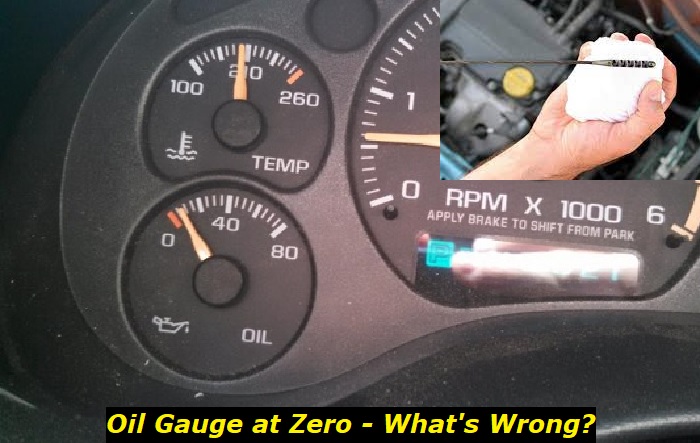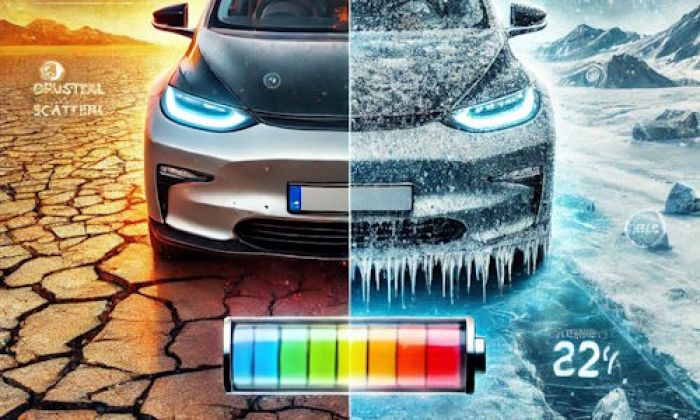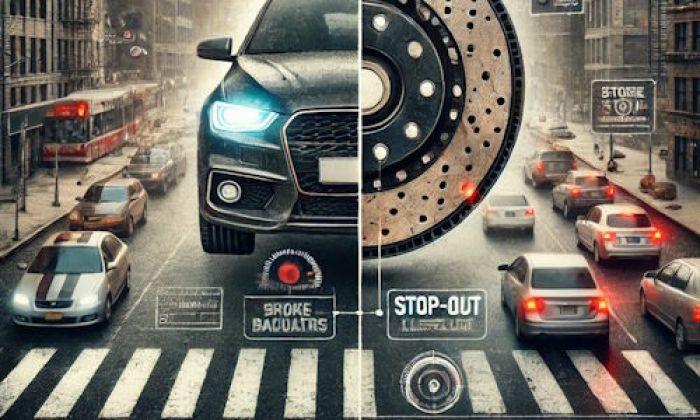The oil gauge is a measurement device on the car's dashboard that helps you track the oil pressure in the engine. Not all vehicles have an oil gauge. However, for those that do, it can be a source of worry if the oil pressure reading from the indicator is zero when the engine is running.
Engine electronics problems highlights
- Level of urgency:Medium
- DIY inspection:Very complicated
- DIY repair:Impossible
- Cost of repair:$250 - $450
- Can you drive?Usually, yes
- Commonreasons:Electronic control modules failure, electrical contacts problems, wiring issues, software problems
- Ways to fix:Usually, professional inspection and repair needed only

Oil Pressure Gauge: What It Is and How It Works
The oil pressure gauge is a powerful instrument in a car equipped with one. It is one of the tools that helps indicate the current well-being of your vehicle's engine. The oil pressure gauge lets users know how much pressure the engine oil is under. Oil pressure is crucial to oil circulation around the engine. Without adequate oil pressure, the engine will not be well-lubricated. Reduced lubrication will cause friction among the engine parts. That friction can damage the engine or one of its components.
The oil pressure gauge uses a connected sensor to measure the oil's pressure as it flows through the engine. The oil gauge measures the oil pressure in one of the major pathways for oil flow near the oil pump and filter.
There are two types of gauges: electric and mechanical. Electric meters are more common in modern vehicles, smaller, and easier to connect. But some people find mechanical gauges more trustworthy. In some cars, you will see an oil warning light instead of an oil pressure gauge. Some vehicles have both.
The oil pressure gauge receives information from the sensing unit and displays it to the user in real-time. The gauge shows the oil pressure in Pounds Per Square Inch (PSI) or Kilopascals (kPa). The preferred oil pressure range varies depending on the car. Yet, generally, the ideal range for oil pressure ranges between 25 and 65 PSI (172 to 448 kPa). The recommended value for your automobile may differ slightly. You can find specifications for oil pressure in your vehicle's service manual.
Common Causes of a Reading of Zero from The Oil Pressure Gauge
Zero reading on the oil pressure gauge should only occur when the engine is off or idle. An oil pressure reading of zero while driving, especially at high speeds, is a problem. A few things can cause this problem; we discuss them below.
1) Low or Contaminated Engine Oil
As known, oil is essential for lubrication, and its absence or inadequacy can cause severe problems in the engine. So, if the oil levels are shallow, the sensor will detect it and communicate it to you through the gauge so that you can remedy the problem.
You can confirm if the oil level is the problem by inspecting the oil levels in the engine. One way to check oil levels is to examine the dipstick in your engine to see if the oil level has dropped below the minimum point. Also, watch for the oil warning light, also known as the idiot light. An illuminated idiot light usually means that your engine has low oil pressure.
Lastly, there may be an oil leak somewhere in the engine. A leak will lead to low engine oil and low oil pressure in the engine. A common sign of an oil leak is puddles of oil gathering underneath where you pack the car. Also, there might be a leak if you find yourself topping up the oil frequently.
Besides checking the oil levels, you should also check the oil for contaminated oil. Contaminated engine oil can hinder proper engine lubrication and cause low oil pressure reading in your car. It is crucial to replace engine oil now and then because of contamination and degradation.
Solution
If you discover the engine is low on oil, top it up. In doing so, ensure you use the right oil for your car, as oils have differing specifications. Check your vehicle manual for the oil specifications for your engine.
Further, if the oil is contaminated, replace it. Oil degrades with time. Check your car's manual for details on how frequently you should change the oil. If you have reason to suspect an oil leak, consult your mechanic to help detect and fix the source of the leak.
2) Faulty Oil Pressure Gauge/Sensor
If the oil pressure reading is zero, a faulty gauge/sensor is the best-case scenario for you and your car. Suppose you have confirmed the adequacy of oil in the engine and the engine performance is stable without any unusual noises, high temperatures, or oil leaks. In that case, the zero reading may be because of damage to the gauge or the sensing unit. It is also possible that the sensor wiring is defective, not the sensor itself.
Some symptoms of a faulty oil pressure sensor besides inadequate reading include the oil warning light blinking or staying on or an illuminated check engine light. Note that a check engine light can illuminate due to different issues in the engine and not just the oil sensing unit. Additionally, if your vehicle has an Onboard Diagnostic 2 port, you can detect if the sensing unit is faulty through relevant error codes detectable with a scanning device.
Solution
Suppose the oil pressure sensor, sensor wiring, or gauge is the problem. You will need to get the affected part repaired or replaced. Suppose the reading remains zero after replacing or repairing the gauge, sensor, or wiring. In that case, the problem may be with the oil pump.
3) Bad Oil Pump
A low oil pressure reading is a common symptom of a damaged or broken oil pump. An oil pump is a mechanical device in the engine that circulates oil throughout the engine's components and other vehicle parts that need it. Manufacturers design oil pumps to provide enough pressure and flow rate to all the engine components for proper lubrication. If the oil pump suffers damage, oil cannot circulate in the engine. Thus, the sensor will struggle to detect oil pressure, causing a zero reading on the gauge. A faulty fuel pump is a hazardous situation for your engine.
If you have adequate oil and your pressure gauge/sensor is functioning correctly, the oil pump is likely the culprit for the zero reading. Like the other possible causes of low oil pressure, an illuminated engine warning or check engine light could signal a problem with the oil pump. Other symptoms of a damaged oil pump include increased engine temperature, hydraulic lifter noise, and valve train noise.
Solution
You will need to replace a damaged oil pump. A replacement oil pump can be a bit expensive. Yet it is better to replace an oil pump than to suffer engine damage. An engine is more costly to replace. Because of how vital an oil pump is and the complicated nature of performing its replacement, we recommend consulting a qualified mechanic to fix this problem.
Can I Drive My Car with The Oil Pressure Gauge at Zero?
Do not drive your car if the oil pressure gauge is reading zero when the vehicle is operational. Even if the oil pressure is low but not zero, you should not operate it. Driving when the oil pressure gauge is flat due to a damaged oil sensor or gauge may not be an issue. However, it is reckless to make such an assumption unless you have tested and confirmed that the sensor/gauge is the problem.
Zero and low engine oil pressure will lead to increased friction between engine parts and cause a reduction in engine performance and even engine failure. You will have to replace a damaged or blown engine. An engine replacement is quite expensive. So, if the oil pressure is at zero, stop driving immediately, call for help, and get the issue diagnosed and repaired.
How To Prevent Low Oil Pressure
A zero reading outside a damaged sensor/gauge means low oil pressure. Here are some things you can do to prevent it:
- Check Engine Oil Levels Regularly
Low oil levels can cause low oil pressure, reduced lubrication, and poor vehicle performance. So, you should check engine oil levels often to ensure they stay above the minimum level and close to the maximum. Also, change the oil as frequently as your vehicle's manufacturer recommends.
- Use the Correct Oil Specification
Different engine types have differing oil needs. Using the right oil for your vehicle will help the engine circulate the oil better and run well, reducing the chances of low oil pressure. Ensure you use motor oil recommended by your car's manufacturer
- Perform Regular Car Maintenance
Regular vehicle maintenance will help prevent many common car problems, including low oil pressure. Professional car care can help detect issues like an ineffective fuel pump, low oil level, clogged oil filter, etc., that could cause low oil pressure.
- Do Not Overload the Vehicle
Overloading your car puts too much strain on the engine and can lead to low oil pressure.
Conclusion
An oil pressure gauge is one of the most critical tools for knowing the condition of your engine. A zero or low reading from the gauge while driving, especially at increased speeds, is a cause for concern. The most common causes of this issue are low engine oil, a faulty oil pressure gauge/sensor, and a damaged fuel pump. It is inadvisable to keep driving your vehicle if you notice a zero reading from your oil pressure gauge, as you risk damaging the engine.
Checking engine oil levels frequently and using the recommended type of oil can prevent low oil pressure. Also, regular maintenance will reduce the likelihood of low or zero oil pressure readings. Furthermore, we recommend that you consult a mechanic to help detect and fix the problem if the cause of the zero-oil pressure gauge reading is unclear.
About the authors
The CarAraC research team is composed of seasoned auto mechanics and automotive industry professionals, including individuals with advanced degrees and certifications in their field. Our team members boast prestigious credentials, reflecting their extensive knowledge and skills. These qualifications include: IMI: Institute of the Motor Industry, ASE-Certified Master Automobile Technicians; Coventry University, Graduate of MA in Automotive Journalism; Politecnico di Torino, Italy, MS Automotive Engineering; Ss. Cyril and Methodius University in Skopje, Mechanical University in Skopje; TOC Automotive College; DHA Suffa University, Department of Mechanical Engineering






Add comment